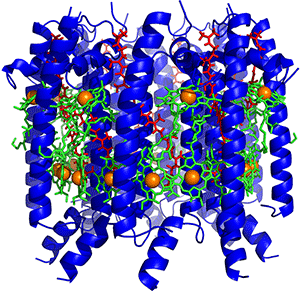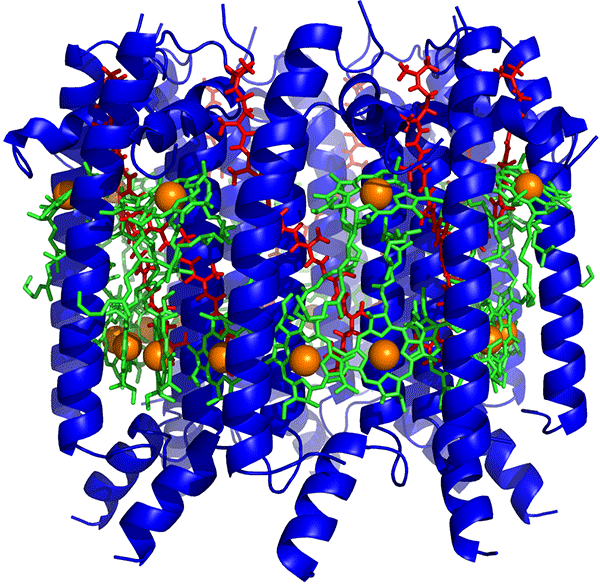Snapshots from the March Meeting—No-Photon Lasers, Hyperbolic Metamaterials, and More
NIF Lasers Put the Squeeze on Metals
The National Ignition Facility (NIF) is most commonly associated with its ambitious goal of achieving laser-driven fusion (see 5 February 2014 Viewpoint). But for a few days a year, a handful of NIF’s laser shots are directed to a completely different kind of experiment. Jon Eggert and Amy Laziki, both at Lawrence Livermore National Laboratory, where NIF is located, reported on their use of specially tailored sequences of the facility’s terawatt laser pulses to compress and heat a variety of materials. . The researchers achieved pressures exceeding 1 terapascal (about 10 million atmospheres) and temperatures above —conditions similar to those found in the mantle of extrasolar planets with masses up to 10 times that of the Earth.
The NIF lasers also generate x rays, which the researchers used to study—under high pressure and temperature conditions—the structural and electronic properties of several materials found in planetary mantles, such as carbon, tin, tantalum, and lead. Up until now, scientists have only been able to rely on theory to predict the properties and phase diagrams of these materials under extreme conditions. The results from NIF may therefore provide important information for planetary science, such as how a material’s structure contributes to mantle viscosity and convection.
Eggert said similar experiments could be used to bring carbon into a never-observed phase that, according to theory, may only be reachable at extremely high pressures. This new allotropic form of carbon would, like diamond, be metastable under ordinary conditions, but it may be even tougher than the world’s hardest material.
Quantum Mechanics Helps Photosynthesis
Plants, birds, and bugs all depend on quantum behavior to accomplish biological tasks efficiently, said MIT’s Seth Lloyd at the Physics-sponsored pizza-and-beer event. He focused mainly on a critical step in photosynthesis: A photon is absorbed by one complex in a giant biomolecular structure, and then the energy—in the form of an exciton—must be transported efficiently to another complex, where the exciton is converted into chemical energy (see Fig. 1). Biologists have traditionally described this exciton transport as the result of many random hops of the particle from one small, chlorophyll-like complex to another, en route to the final complex. But researchers have lately found signs that the exciton can also move as a coherent, quantum wave, rather than a classical particle.
Lloyd and his colleagues modeled the process using the molecular structures of a specific bacterium. One surprise, he said, was that this structure performed better at room temperature than at the lower temperatures normally needed to preserve a quantum wave’s coherence. According to Lloyd, the problem at low temperatures is that waves scatter and interfere destructively in the somewhat disordered molecular structure, which prevents the wave from propagating very far. At higher temperatures, the jiggling of the structure essentially allows the exciton to periodically decohere and hop like a classical particle before resuming wavelike propagation. But if the temperature is too high, efficiency drops because the exciton spends too much time acting like a classical particle, which moves more slowly than a wave. It seems that evolution has perfected the structure through trial and error to provide the ideal compromise of classical and quantum behavior, said Lloyd. He even performed an “interpretive dance” demonstrating the exciton’s motion (see video).
Hyperbolic Metamaterials Heat Up
The spectrum of thermal radiation from a hot object like the Sun ordinarily follows the standard black body formula: a smooth curve peaked at a wavelength that depends on the object’s temperature. Such a heat source could be used to run a photovoltaic cell, which turns thermal radiation into electricity, but most of the thermal radiation will be wasted if the source and cell aren’t well matched in wavelength. Zubin Jacob of the University of Alberta and his colleagues hope to engineer thermal emission spectra using so-called hyperbolic metamaterials. The idea is to produce extra radiation (in the near field) in a specific range of wavelengths that optimizes the efficiency of a nearby photovoltaic cell. The metamaterials could run on waste heat from other sources, so they wouldn’t require any additional energy to operate.
In a session that focused on the interaction between light and matter, he described his team’s experiments with the first thermal hyperbolic metamaterials. These materials involve nanoscale structures that generate extreme anisotropy, for example, exhibiting highly reflective metallic behavior in one direction while being transparent along the perpendicular direction.
The anisotropic structures lead to resonances or modes for thermal fluctuations at certain frequencies, which then affect the thermal radiation spectrum. To create the anisotropy, the team built two types of structures: an array of parallel metal nanowires in a dielectric matrix and a set of metal layers interleaved with dielectric layers. Jacob showed preliminary absorption spectra of these structures. The data demonstrate that his team can affect the absorption spectrum—and therefore, similarly, the emission spectrum—by changing the dielectric constant and the geometry. The next step will be to measure the thermal radiation spectra. Jacob said that applications beyond photovoltaics are likely once this new type of radiation source is available.
Could a No-Photon Laser Measure the Universe?
Precise timekeeping is key to many applications, from global positioning systems to testing the fundamental laws of physics. In recent years, teams from JILA, NIST, and the University of Colorado have developed some of the most accurate clocks in the world using the light emitted by cold atoms or ions as a frequency standard. These atomic clocks are so stable that the time measured by two of them over the age of the Universe would differ at most by one second.
In a session on synchronization in “micro and macro worlds,” Murray Holland of JILA said that the ticket to even greater clock accuracy may, counterintuitively, come from a laser that emits almost no light. The precision of atomic clocks is fundamentally linked to the stability of the laser that excites the cold atoms. In 2012, Holland teamed with JILA researchers James Thompson and Jun Ye to demonstrate a new laser concept based on a phenomenon called “superradiance.” While in a conventional laser the amplitude and phase of the emitted light are stored in the light traveling between two mirrors, in a superradiant laser they are stored in the atoms as collectively synchronized excitations. The optical cavity contains very few photons (on average less than one), and the emission frequency is determined by narrow atomic transitions, rather than by the length of the cavity. This enhances the laser stability by reducing the impact of mirrors’ fluctuations. Holland believes that, with further improvements, such a device could lead to clocks that are 100 times more accurate than the best clocks available today.
At this level of accuracy, scientists should be able to see the change in an atomic clock’s tick frequency that comes from the proximity of a massive object—an effect that could be used to monitor earthquakes, water depletion, or volcanic activity. Beyond clocks, researchers may find other applications for the long coherence time of no-photon lasers, which could reach 1000 seconds, or roughly twice the amount of time it takes light to travel from the Sun to the Earth. Light beams from these lasers could be sent into space to measure astronomic distances with laser-wavelength precision, making the no-photon laser the best available ruler of the Universe.
– Matteo Rini and David Ehrenstein





